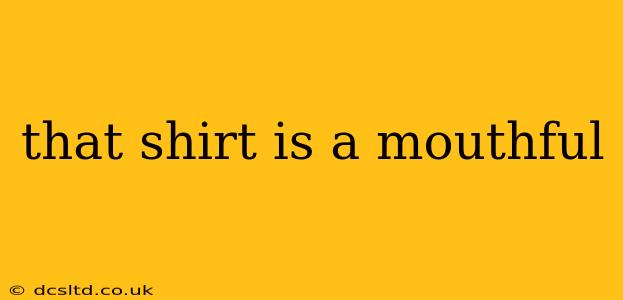That Shirt's a Mouthful: Decoding Fashion's Most Descriptive Terms
We've all been there. Browsing online or in a store, you see a shirt described with a phrase so long and complicated it feels like a tongue twister. "Oversized, textured, asymmetric dolman sleeve, waffle-knit, oatmeal-colored henley"? It's enough to make anyone throw their hands up in frustration! This article breaks down the often-confusing language used to describe shirts, making your next shopping experience a breeze.
What does "a mouthful" even mean in fashion?
When we say a shirt description is "a mouthful," we mean it's excessively long, uses overly technical or unfamiliar terms, and generally makes the garment sound more complicated than it needs to be. This is often a result of brands trying to showcase every detail, leading to overly descriptive and confusing wording. The goal, however, is to help you understand the garment's features; unfortunately, it often backfires, making it difficult for consumers to grasp the essential aspects of the shirt.
Why are shirt descriptions so complicated?
Several factors contribute to the complexity of shirt descriptions:
- Specificity: Brands aim for precision, detailing every nuance of the garment's design, fabric, and fit. While well-intentioned, this can lead to overwhelming descriptions.
- Marketing Jargon: The fashion industry uses specialized terminology that isn't always intuitive to the average shopper. Terms like "dolman sleeve" or "waffle-knit" might be commonplace for designers, but not for everyone.
- Targeting Specific Niches: Certain brands cater to consumers with a deep understanding of fabrics and styles, leading them to use more technical language.
What are some common "mouthful" terms and what do they mean?
Let's break down some common culprits:
- Oversized: This simply means the shirt is larger than standard sizing, providing a relaxed, loose fit.
- Textured: The fabric has a raised or uneven surface, adding visual interest. This could be due to weaving techniques, knitting patterns (like waffle-knit), or added embellishments.
- Asymmetric: The shirt's design isn't symmetrical; one side might be longer or have a different detail than the other.
- Dolman Sleeve: These sleeves are wider at the shoulder and taper towards the cuff, often with a dropped shoulder seam.
- Waffle-Knit: A type of knit fabric with a textured pattern resembling a waffle. It's usually soft and breathable.
- Henley: A shirt with a placket (a band of fabric with buttons or snaps) instead of a full button-front.
- Oatmeal-colored: A light beige or grayish-brown color.
How can I understand shirt descriptions better?
- Look at the images: Carefully examine the product photos from multiple angles. This provides a visual understanding of the shirt's features.
- Check the size chart: Pay close attention to the measurements to determine if the shirt will fit correctly.
- Read reviews: See what other customers say about the shirt's fit, fabric, and overall quality. Their experiences often clarify confusing descriptions.
- Don't be afraid to ask: If you're still unsure, contact the retailer's customer service for clarification.
Is it better to use simpler descriptions?
While detailed descriptions aim for accuracy, simpler language can improve clarity and enhance the customer experience. A balance between providing sufficient detail and maintaining readability is key for effective communication.
By understanding the common terminology and utilizing the tips above, you can confidently navigate the world of shirt descriptions, no longer intimidated by those "mouthfuls." Happy shopping!
